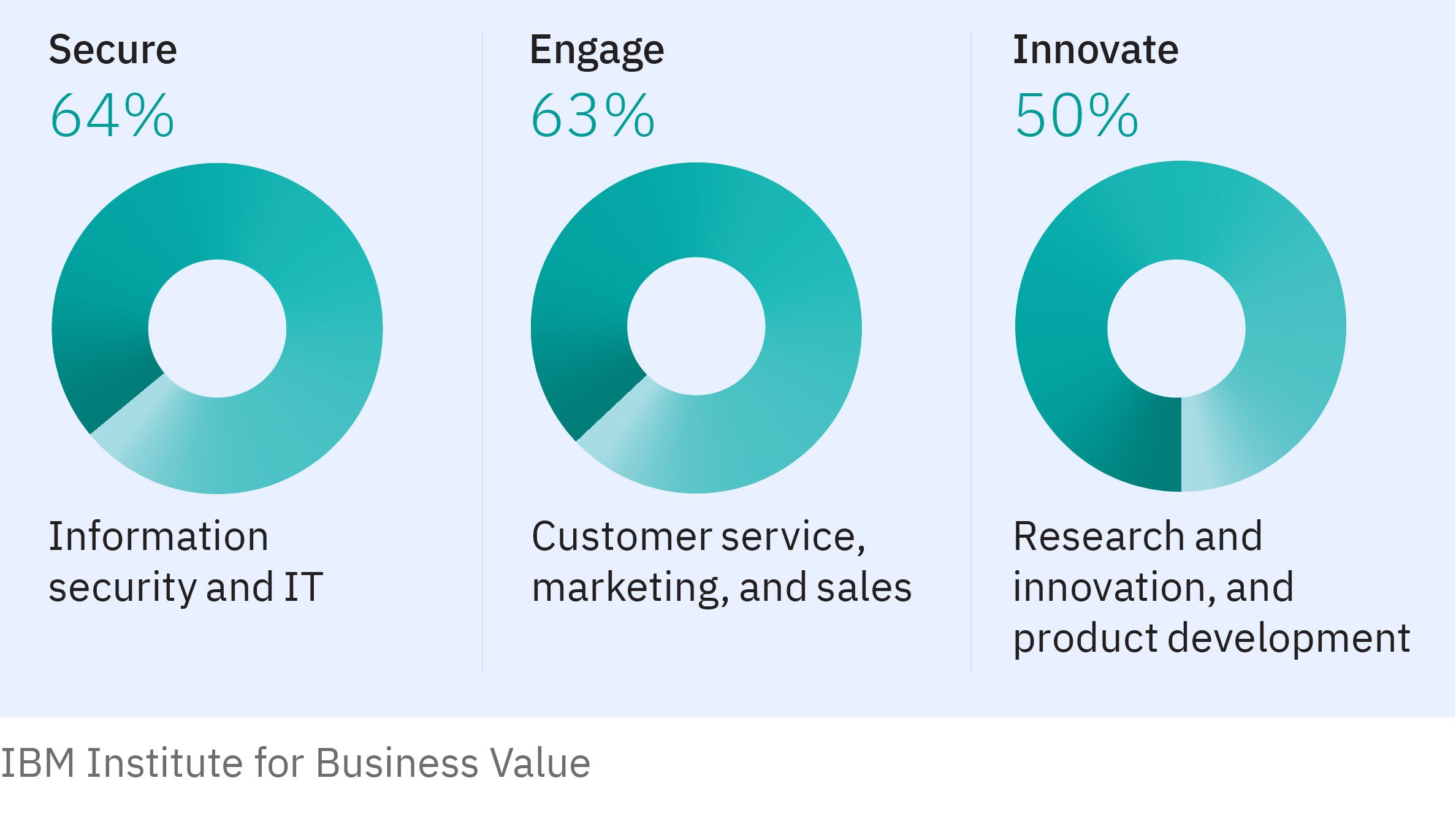The generative AI debate is often reduced to extremes. As enthusiasts and skeptics struggle to control the conversation, the middle ground often gets lost. And that’s a big problem for business leaders, who need to base their approach to artificial intelligence on cold, hard facts and strategic relevance—not hubris and hyperbole.
To offer a more sober assessment, the IBM Institute for Business Value (IBV), in partnership with Oxford Economics, surveyed almost 400 executives across the United States, Australia, Germany, India, Singapore, and the UK in May 2023. At the same time, we also surveyed 200 CEOs in the US. We asked business leaders about their plans for adopting generative AI, benefits they expect to see, and barriers holding them back.
64% of CEOs say they face significant pressure from investors, creditors, and lenders to accelerate adoption of generative AI.
We found that, despite the ChatGPT-fueled hype, executives are advancing cautiously around generative AI. Leaders today are better acquainted with generative AI than they were with traditional AI in 2016, amid the first AI hype cycle. As a result, executives have a much more focused view of where to deploy generative AI. Today, they’re much clearer on which use cases and AI applications they see as driving the most value. Our data shows that, at least initially, leaders are focused on three key priorities.
Execs have identified three priorities for generative AI adoption

Of course, organizations are still tailoring specific generative AI use cases to their own strategic capabilities and business priorities. For example, IBM’s Chief Analytics Office—a critical part of its broader Transformation & Operations area—is focusing on applying generative AI in IT and application modernization, customer service, and employee engagement, all underpinned by automation.
Scaling generative AI
Awareness has reached the C-suite quickly, but there is a gap between this awareness and the ability to deliver value at scale. The priority areas that executives identified are those with the most mature AI capabilities. This means many organizations are falling short of executing AI initiatives that will deliver strategic value for the entire enterprise.
CEOs may be focused on quick wins because they feel the need to act fast. 64% of CEOs say they face significant pressure from investors, creditors, and lenders to accelerate adoption of generative AI. And over half say their employees are pushing for faster adoption. Consequently, investment in generative AI is expected to grow 4x over the next two to three years—although it remains, at least for now, a fraction of total AI spend.
Four in five executives see at least one trust-related issue as a roadblock to generative AI adoption.
What’s holding organizations back from doing more with generative AI? In a word: trust. Four in five executives see at least one trust-related issue as a roadblock to generative AI adoption. Cybersecurity, data privacy, and accuracy top the list, and they also have broader concerns about explainability, ethics, and bias in both data sources and the responses that models deliver.
And these concerns are grounded in what’s happening in the world today. Generative AI has quickly become consumerized, which means some individuals are learning how to use it without formal instruction. They’re experimenting without guardrails—and flying under the radar with unpredictable consequences.
What is generative AI? What are foundation models?
Generative AI refers to deep-learning models that can generate high-quality text, images, and other content based on a large volume of training data. This ability to generate novel data has ignited a rapid-fire succession of new technologies.
Today’s large language models (LLMs) are trained on large datasets—and can even be pre-trained without a particular task in mind. Enterprises can later specialize these AI models, known as foundation models, with much less enterprise data to perform a given task.
Foundation models offer an opportunity to accelerate and scale generative AI adoption, as they can, in theory, be applied to many domains. For example, massive-parameter LLMs can transform how information is generated and shared across an organization and the broader ecosystem.
While foundation models offer real promise and potential, they also come with new challenges. For one, they require significant compute, storage, and network resources, which makes them energy intensive. Training one large natural language processing model has roughly the same carbon footprint as running five cars over their lifetime.
Like any other disruptive technology, there are trade-offs that come with adopting foundation models and other generative models. Especially for enterprises, this journey will involve balancing the scales between the value generative AI can create and the investment it demands.
Prepare for a generative AI future
Without the proper oversight, organizations are unable to correctly identify, quantify, or manage the risks inherent to adopting any emerging technology. The first step toward harnessing the power of generative AI safely and responsibly is understanding what the organization wants to achieve and what needs to change to make that vision a reality.
To close the readiness gap and accelerate generative AI adoption, businesses leaders need to focus on three areas:
- Organization and skills
- Data and platform
- Risk and governance
Download the full report to see what outcomes executives are prioritizing with their generative AI investments—and how they can transform to accelerate enterprise-wide adoption.





